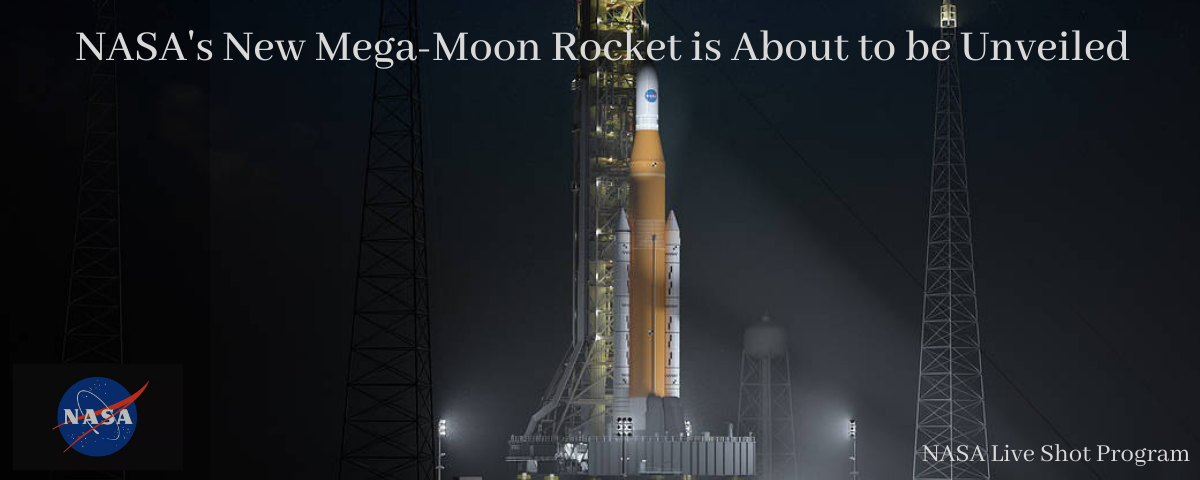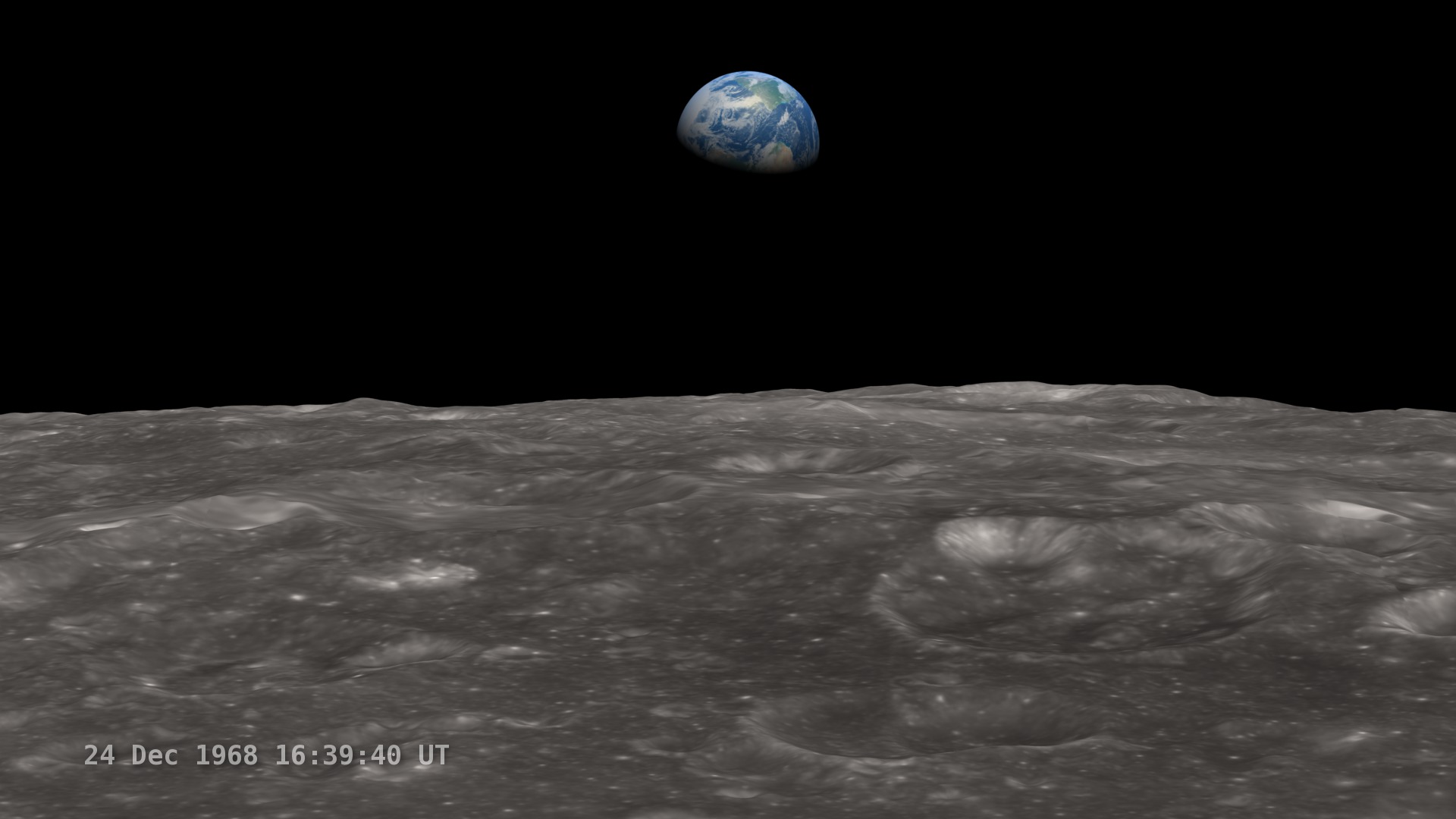A newer version of this visualization is available.
Earthrise: The 45th Anniversary
In December of 1968, the crew of Apollo 8 became the first people to leave our home planet and travel to another body in space. But as crew members Frank Borman, James Lovell, and William Anders all later recalled, the most important thing they discovered was Earth.
Using photo mosaics and elevation data from Lunar Reconnaissance Orbiter (LRO), this video commemorates the 45th anniversary of Apollo 8's historic flight by recreating the moment when the crew first saw and photographed the Earth rising from behind the Moon. Narrator Andrew Chaikin, author of A Man on the Moon, sets the scene for a three-minute visualization of the view from both inside and outside the spacecraft accompanied by the onboard audio of the astronauts.
The visualization draws on numerous historical sources, including the actual cloud pattern on Earth from the ESSA-7 satellite and dozens of photographs taken by Apollo 8, and it reveals new, historically significant information about the Earthrise photographs. It has not been widely known, for example, that the spacecraft was rolling when the photos were taken, and that it was this roll that brought the Earth into view. The visualization establishes the precise timing of the roll and, for the first time ever, identifies which window each photograph was taken from.
The key to the new work is a set of vertical stereo photographs taken by a camera mounted in the Command Module's rendezvous window and pointing straight down onto the lunar surface. It automatically photographed the surface every 20 seconds. By registering each photograph to a model of the terrain based on LRO data, the orientation of the spacecraft can be precisely determined.
Andrew Chaikin's article Who Took the Legendary Earthrise Photo From Apollo 8?
appeared in the January, 2018 issue of Smithsonian magazine. It includes the story of the making of this visualization.
A Google Hangout discussion of this visualization between Ernie Wright (creator of the visualization), Andrew Chaikin, John Keller (LRO project scientist), and Aries Keck (NASA media specialist) was held on December 20, 2013. A replay of that hangout is available here.
Ernie Wright presented a talk about the making of this animation at the 2014 SIGGRAPH Conference in Vancouver. He also wrote a NASA Wavelength blog entry about Earthrise that includes links to educator resources related to LRO.
The full video, with narration by Andrew Chaikin. You can also watch this video on the NASAexplorer YouTube channel. For complete transcript, click here.
This video is also available on our YouTube channel.
The central portion of the video, covering the real-time visualization synchronized with the onboard astronaut audio.
An external view of the spacecraft as the Earth rises in the distance. The first frame corresponds to 10:37:19 a.m. Central Standard (Houston) Time, 16:37:19.0 Universal Time, and 75:46:19.0 Mission Elapsed Time. The frames cover an elapsed time of exactly three minutes. This frame set and several of the others are synchronized in time.
An idealized view of Earth rising above the lunar terrain, using a focal length similar to the telephoto lens used for the Earthrise photographs. For the 1920 × 1080 frame set, the first frame corresponds to 75:47:06 MET, which is 47 seconds (1410 frames) later than the other synchronized frame sets. The 3840 × 2160 frame set covers the full three-minute interval starting at 75:46:19 MET.

The three Earthrise photographs, scaled and rotated to match the telephoto view of the preceeding frame set. They correspond to frames 1092, 2814, and 3545 of the 1920 × 1080 frames, and to frames 2502, 4224, and 4955 of the 3840 × 2160 frames. The original photographs are AS08-13-2329, AS08-14-2383, and AS08-14-2384.
A nadir view of the lunar surface, overlaid with Apollo 8 vertical stereo photographs. This frame set is synchronous with others that begin at 75:46:19 MET. It shows photos AS08-12-2135 through AS08-12-2144 on magazine D.
The wide-angle view of the Moon and Earth through the right side window (window 5). These frames are synchronous with others that begin at 75:46:19 MET. The 1920 × 1080 frame set is partial, covering frames 2000 through 3800. The 3840 × 2160 frame set is complete.
The wide-angle view of the Moon and Earth through the right rendezvous window (window 4). These frames are synchronous with others that begin at 75:46:19 MET. The 1920 × 1080 frame set is partial, covering frames 3600 to 5400. The 3840 × 2160 frame set is complete.
The wide-angle view of the Moon and Earth through the hatch window (window 3). These frames are synchronous with others that begin at 75:46:19 MET.
The window border for the right rendezvous window (window 4).
The window border for the right side window (window 5).

The window border for the hatch window (window 3).
The head-up display of the time and the position and orientation of the spacecraft. These frames are synchronous with others that begin at 75:46:19 MET.
A nose-on view of the spacecraft as it begins to roll. This highlights the positions of the windows relative to the roll direction. The frames are synchronous with other frame sets that begin at 75:46:19 MET, but the coverage is partial, from frame 540 to 900.
A view of the spacecraft during an early orbit, showing that the windows faced away from Earth.
Through high thin clouds, a naked-eye view of the Moon from Earth on December 24, 1968. The Moon is a waxing crescent in the constellation Aquarius.
A telescopic view of the Moon from Earth as the spacecraft emerges from the far side. The position of the CSM is represented by a white dot, but the spacecraft could not be seen in even the most powerful telescopes.
The lunar terrain rolls beneath the camera as it chases the spacecraft, seen from a great distance.
A nose-on animated illustration of the command module showing the positions of the five windows. From left to right, the windows are numbered in descending order from 5 to 1.
A view of the rolling spacecraft used in the video to call out the windows in which the Earth is visible.
For More Information
Credits
Please give credit for this item to:
NASA's Scientific Visualization Studio
Andrew Chaikin appears courtesy of the Lunar and Planetary Institute. Spacecraft model by Stuart Howes.
-
Animator
-
Ernie Wright
(USRA)
-
Ernie Wright
(USRA)
-
Video editor
- Dan Gallagher (USRA)
-
Narration
-
Narrator
-
Producers
- Dan Gallagher (USRA)
-
Ernie Wright
(USRA)
- Andrew Chaikin
-
Noah Petro
(NASA/GSFC)
-
Scientists
- John Keller (NASA/GSFC)
-
Noah Petro
(NASA/GSFC)
- Richard Vondrak (NASA/GSFC)
Missions
This page is related to the following missions:Series
This page can be found in the following series:Tapes
The media on this page originally appeared on the following tapes:-
Earthrise 45th Anniversary
(ID: 2013102)
Thursday, December 19, 2013 at 5:00AM
Produced by - Dan Jacob (Global Science and Technology, Inc.)
Datasets used
-
Blue Marble [Terra: MODIS]
ID: 492Credit: The Blue Marble data is courtesy of Reto Stockli (NASA/GSFC).
See all pages that use this dataset -
DEM (Digital Elevation Map) [LRO: LOLA]
ID: 653 -
Apollo 8 Trajectory Reconstruction
ID: 735This dataset can be found at: http://ntrs.nasa.gov/archive/nasa/casi.ntrs.nasa.gov/19740072902_1974072902.pdf
See all pages that use this dataset -
WAC 643nm High Sun Global Mosaic [LRO: LROC]
ID: 803
Note: While we identify the data sets used on this page, we do not store any further details, nor the data sets themselves on our site.
Release date
This page was originally published on Friday, December 20, 2013.
This page was last updated on Sunday, January 5, 2025 at 10:27 PM EST.




